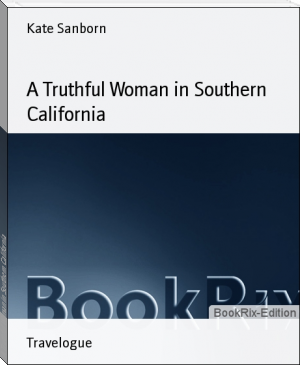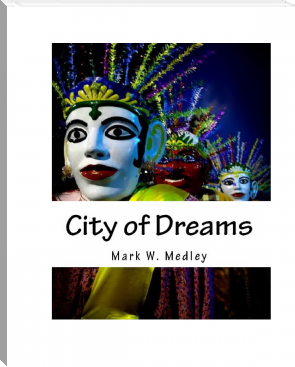A Truthful Woman in Southern California, Kate Sanborn [best thriller novels of all time .txt] 📗

- Author: Kate Sanborn
Book online «A Truthful Woman in Southern California, Kate Sanborn [best thriller novels of all time .txt] 📗». Author Kate Sanborn
had run back to get her child, and the ship went off without her. Nidever tells his story in this way:
"We scattered off two or three hundred yards apart. She had a little house made of brush and had a fire; she was sitting by the fire with a little knife; she was working with it. She had a bone; all came up and looked at her; she had a heap of roots - that is what she lived on - and had little sacks to carry them in. As soon as we sat down she put a lump of them to roast on the fire. Finally we got ready to go, and we made signs for her to come with us. She understood the signs for her to come with us; she picked up her things to take them on board."
She had a dress made of duck skins, sewed together with the sinews of a seal, with needles made of bone - an eye drilled through. This dress the priests sent to Rome.
The demijohn in which she carried water was made out of rushes and stopped with asphaltum. She was making one of these water bottles. She heated small round stones in the fire and put them in the asphaltum, and then lined the bottle, making it tight. She had no matches, of course, nor even a tinder-box, but started fire by rubbing two sticks together.
She said her child was eaten up by wolves. None of the Indians understood her dialect; finally one woman was found who could talk to her a little, who had been raised on the same island. The woman was found in 1853. She seemed happy and contented, and would go round to different houses and dance the Indian dances. She was a great curiosity; twenty or thirty would go along with her. Many who were sailing by would stop just to see her.
The other hunters had noticed small human tracks, but never could see any one. At last several men were scattered all over the island, and Charlie Brown was the first to discover her. He thought at first it was only a black crow sitting on a whalebone. I give his version, as his language is far more picturesque and vivid than my paraphrase would be. He says:
"She had built a brush fence about two feet high to break the wind. The sun was coming in her face. She was skinning a seal. The dog when he noticed me he began to growl. I thought if she should run. I stepped right round her, and she bowed as if she knew me before, and when the Indians came up they all kneeled down, and when she saw there was some of her color, she held out some of her food and offered all some.
"I took her by the shoulder, and I said, ' Varmoose ,' and she understood at once. I took everything she had, and she took a big seal head in basket. We all had something to carry. Then she had a little brand of fire, and she took that away and wobbled along with a strange kind of a step like until we came to a watering-place about fifty feet down the bank, and they all went down there and she went too, and she sat down there and we watched to see what she would do, and she washed herself over; her hair was all rotting away, a kind of bleached by the sun, and we got to the vessel and she kneeled down, and we had a stove right on deck and she crawled to the stove and we gave her a piece of biscuit and she ate like a good fellow. It came on to blow; old man Nidever had some bed-ticking. I made her a dress, and gave her a man's shirt. She was tickled to death. If I was where she was she would hold up her dress and point that I made it."
He was asked how she happened to be left, repeated Nidever's story, and added: "She found they were all gone, and commenced to hollo. No answer, and hunted round and saw the tracks and found they went to lower part of the island. When she got there found the vessel going away, and she called, 'Mancyavina,' but it never came. She put her head on the ground and laid on the ground and cried, and they never came.
"The priest here had all the Indians in Santa Barbara and Santa Inez to see if they understood her. They could understand some words, but not all. She got baptized, and they made her a Christian and everything. A steamer came up from below; the captain offered to take her up and show her, but old man Nidever would not agree. She died; they gave her green corn and melons, and they were too much for her. She made knives of bone and wood, and had pointed nails for catching fish. She had ropes nicely twisted with sinews, twisted as true as any rope-maker could make, and had bottles made of grass, and dishes of wood with handles; she put the feathers next her skin to keep warm."
I will only add that wild dogs were numerous, and she tamed them for friends. The priests called her Juana Maria, and I think the name of the island should be changed in her honor. I doubt if Santa Barbara herself could have done as well under similar circumstances.
CHAPTER XII.
HER CITY AND COUNTY.
"Syrian apples, Othmanee quinces,
Limes and citrons and apricots,
And wines that are known to Eastern princes."
In walking through the streets of Santa Barbara you may still see the various types, but not so clearly defined as of old. Holy Fathers still intone the service within the massive mission walls; they still cultivate the large garden, from which woman is sedulously excluded. But the faces are German and Irish. At a street corner two men are talking earnestly, and as you pass you get a glance from Mexican eyes, dark and soft, but the hair shows Indian blood. A real old Mexican vaquero rides by in the genuine outfit, well worn and showing long use; next a carriage full of fashionable visitors; then a queerer combination than the Anglomaniac with his trousers legs turned up if the cable reports a rainy day in London. This is the American vaquero - usually a short, fat man with dumpy legs, who dons a flapping sombrero, buys a new Mexican saddle, wooden stirrups, and leather riata, sometimes adding a coil of rope at left side, wears the botas with a corduroy suit at dinner at hotel, and doesn't know at all how comical an appearance he presents. The very next to pass is one of the pioneers, who, although worth a million or more, puts on no style, and surveys the mongrel in front with a twinkle in his eye. Every one should own a horse or pony or burro here, for the various drives are the greatest charm of the place. Through all Southern California the happy children ride to school, where the steeds, fastened to fence in front of building, wait patiently in line, like Mary's lamb. But in Santa Barbara you see mere tots on horseback, who look as if it were no new accomplishment. I believe the mothers put them on gentle ponies to be cared for, or safe, as mothers in general use the cradle or high-chair. One of the old Mexican residents of Santa Barbara, when over eighty years of age, had the misfortune to break his leg. He lay in bed uneasily until a surgeon could be summoned and the fractured bones set and duly encased in plaster. He then insisted on being carried out and placed upon his favorite horse, where he sat during each day with patient serenity until the damage was repaired by nature.
The drives are all delightful. You cannot make a mistake; there are twenty-eight drives distinct and beautiful. Those best known are, to the Mission Cañon, to the Lighthouse, to Montecito and Carpenteria, Cooper's Ranch, through the far-famed Ojai Valley, and the stage or coaching trip to San Luis Obispo, not forgetting La Vina Grande (the big grapevine), the trunk eighteen inches in diameter, foliage covering 10,000 square feet, producing in one year 12,000 pounds of grapes; and the Cathedral Oaks. I jotted down a few facts at the Lighthouse a la Jingle in
Pickwick Papers : gleaming white tower, black lantern, rising from neat white cottage, green window-shutters, light 180 feet above sea-level, fine view from balcony, fields of young barley down to water's edge, bluest blue in sea and sky, the lamp holds only one quart of oil, reflectors do big business, considering, throwing the light 417 miles.
The keeper, a woman, has been there over thirty years, never goes away for a single night, trim, quaint, and decided, doesn't want to be written up, will oblige her, don't believe a woman ever did so much good with a quart of kerosene daily before. Been a widow a long time, heard of one woman, wife of lighthouse-keeper, he died, she too stout to be gotten out of the one room, next incumbent married her.
Montecito, as Roe described it, is a village of charming gardens and green lawns, with a softer climate even than Santa Barbara - a most desirable situation for an elegant country retreat. I had the privilege of visiting the home of Mr. W. P. Gould, a former resident of Boston, who has one of the most perfect places I have ever seen. He has been experimenting this year with olive oil in one room of his large house for curing lemons, and has perfected a machine which expresses the "virgin oil" without cracking a single pit or stone. This is a great improvement, as one crushed stone will give an acrid taste to a quart of oil. There is a fashion in fruits as much as in bonnets or sleeves. Olive culture is just now the fad. Pears, prunes, almonds, walnuts, have each had their day, or their special boom. Pomona is headquarters for the olive industry. Nursery men there sold over 500,000 trees last year. The tree does not require the richest soil. Hon. Elwood Cooper's olive oil is justly famous, but the machinery designed by Mr. Gould makes a much purer oil, pronounced by connoisseurs to be the finest in the world. The olives are sun-dried; the ponderous rollers and keen knives of the masher mash the fruit, and every after-process is the perfection of cleanliness and skill. There is a nutty sweetness about this oil, and a clear amber color, which makes it most desirable for the fastidious invalid.
This new process has been purchased by a company who are going to try to give the country what it has never known before - pure olive oil, free from a bit of the stone. No pure oil is brought to our country. The public think the price too high; they prefer to buy cotton-seed oil at thirty-five cents a gallon, and this is adulterated with peanuts, sunflowers, and so on. This will do for the masses, but the best is none too good if it can be found.
Few appreciate the medicinal value of olive oil. Nations making use regularly of this and the fruit are freed from dyspepsia. A free use in the United States would round out Brother Jonathan's angular spareness of form, and make him less nervous and less like the typical Yankee of whom the witty Grace Greenwood said: "He looks as if
"We scattered off two or three hundred yards apart. She had a little house made of brush and had a fire; she was sitting by the fire with a little knife; she was working with it. She had a bone; all came up and looked at her; she had a heap of roots - that is what she lived on - and had little sacks to carry them in. As soon as we sat down she put a lump of them to roast on the fire. Finally we got ready to go, and we made signs for her to come with us. She understood the signs for her to come with us; she picked up her things to take them on board."
She had a dress made of duck skins, sewed together with the sinews of a seal, with needles made of bone - an eye drilled through. This dress the priests sent to Rome.
The demijohn in which she carried water was made out of rushes and stopped with asphaltum. She was making one of these water bottles. She heated small round stones in the fire and put them in the asphaltum, and then lined the bottle, making it tight. She had no matches, of course, nor even a tinder-box, but started fire by rubbing two sticks together.
She said her child was eaten up by wolves. None of the Indians understood her dialect; finally one woman was found who could talk to her a little, who had been raised on the same island. The woman was found in 1853. She seemed happy and contented, and would go round to different houses and dance the Indian dances. She was a great curiosity; twenty or thirty would go along with her. Many who were sailing by would stop just to see her.
The other hunters had noticed small human tracks, but never could see any one. At last several men were scattered all over the island, and Charlie Brown was the first to discover her. He thought at first it was only a black crow sitting on a whalebone. I give his version, as his language is far more picturesque and vivid than my paraphrase would be. He says:
"She had built a brush fence about two feet high to break the wind. The sun was coming in her face. She was skinning a seal. The dog when he noticed me he began to growl. I thought if she should run. I stepped right round her, and she bowed as if she knew me before, and when the Indians came up they all kneeled down, and when she saw there was some of her color, she held out some of her food and offered all some.
"I took her by the shoulder, and I said, ' Varmoose ,' and she understood at once. I took everything she had, and she took a big seal head in basket. We all had something to carry. Then she had a little brand of fire, and she took that away and wobbled along with a strange kind of a step like until we came to a watering-place about fifty feet down the bank, and they all went down there and she went too, and she sat down there and we watched to see what she would do, and she washed herself over; her hair was all rotting away, a kind of bleached by the sun, and we got to the vessel and she kneeled down, and we had a stove right on deck and she crawled to the stove and we gave her a piece of biscuit and she ate like a good fellow. It came on to blow; old man Nidever had some bed-ticking. I made her a dress, and gave her a man's shirt. She was tickled to death. If I was where she was she would hold up her dress and point that I made it."
He was asked how she happened to be left, repeated Nidever's story, and added: "She found they were all gone, and commenced to hollo. No answer, and hunted round and saw the tracks and found they went to lower part of the island. When she got there found the vessel going away, and she called, 'Mancyavina,' but it never came. She put her head on the ground and laid on the ground and cried, and they never came.
"The priest here had all the Indians in Santa Barbara and Santa Inez to see if they understood her. They could understand some words, but not all. She got baptized, and they made her a Christian and everything. A steamer came up from below; the captain offered to take her up and show her, but old man Nidever would not agree. She died; they gave her green corn and melons, and they were too much for her. She made knives of bone and wood, and had pointed nails for catching fish. She had ropes nicely twisted with sinews, twisted as true as any rope-maker could make, and had bottles made of grass, and dishes of wood with handles; she put the feathers next her skin to keep warm."
I will only add that wild dogs were numerous, and she tamed them for friends. The priests called her Juana Maria, and I think the name of the island should be changed in her honor. I doubt if Santa Barbara herself could have done as well under similar circumstances.
CHAPTER XII.
HER CITY AND COUNTY.
"Syrian apples, Othmanee quinces,
Limes and citrons and apricots,
And wines that are known to Eastern princes."
In walking through the streets of Santa Barbara you may still see the various types, but not so clearly defined as of old. Holy Fathers still intone the service within the massive mission walls; they still cultivate the large garden, from which woman is sedulously excluded. But the faces are German and Irish. At a street corner two men are talking earnestly, and as you pass you get a glance from Mexican eyes, dark and soft, but the hair shows Indian blood. A real old Mexican vaquero rides by in the genuine outfit, well worn and showing long use; next a carriage full of fashionable visitors; then a queerer combination than the Anglomaniac with his trousers legs turned up if the cable reports a rainy day in London. This is the American vaquero - usually a short, fat man with dumpy legs, who dons a flapping sombrero, buys a new Mexican saddle, wooden stirrups, and leather riata, sometimes adding a coil of rope at left side, wears the botas with a corduroy suit at dinner at hotel, and doesn't know at all how comical an appearance he presents. The very next to pass is one of the pioneers, who, although worth a million or more, puts on no style, and surveys the mongrel in front with a twinkle in his eye. Every one should own a horse or pony or burro here, for the various drives are the greatest charm of the place. Through all Southern California the happy children ride to school, where the steeds, fastened to fence in front of building, wait patiently in line, like Mary's lamb. But in Santa Barbara you see mere tots on horseback, who look as if it were no new accomplishment. I believe the mothers put them on gentle ponies to be cared for, or safe, as mothers in general use the cradle or high-chair. One of the old Mexican residents of Santa Barbara, when over eighty years of age, had the misfortune to break his leg. He lay in bed uneasily until a surgeon could be summoned and the fractured bones set and duly encased in plaster. He then insisted on being carried out and placed upon his favorite horse, where he sat during each day with patient serenity until the damage was repaired by nature.
The drives are all delightful. You cannot make a mistake; there are twenty-eight drives distinct and beautiful. Those best known are, to the Mission Cañon, to the Lighthouse, to Montecito and Carpenteria, Cooper's Ranch, through the far-famed Ojai Valley, and the stage or coaching trip to San Luis Obispo, not forgetting La Vina Grande (the big grapevine), the trunk eighteen inches in diameter, foliage covering 10,000 square feet, producing in one year 12,000 pounds of grapes; and the Cathedral Oaks. I jotted down a few facts at the Lighthouse a la Jingle in
Pickwick Papers : gleaming white tower, black lantern, rising from neat white cottage, green window-shutters, light 180 feet above sea-level, fine view from balcony, fields of young barley down to water's edge, bluest blue in sea and sky, the lamp holds only one quart of oil, reflectors do big business, considering, throwing the light 417 miles.
The keeper, a woman, has been there over thirty years, never goes away for a single night, trim, quaint, and decided, doesn't want to be written up, will oblige her, don't believe a woman ever did so much good with a quart of kerosene daily before. Been a widow a long time, heard of one woman, wife of lighthouse-keeper, he died, she too stout to be gotten out of the one room, next incumbent married her.
Montecito, as Roe described it, is a village of charming gardens and green lawns, with a softer climate even than Santa Barbara - a most desirable situation for an elegant country retreat. I had the privilege of visiting the home of Mr. W. P. Gould, a former resident of Boston, who has one of the most perfect places I have ever seen. He has been experimenting this year with olive oil in one room of his large house for curing lemons, and has perfected a machine which expresses the "virgin oil" without cracking a single pit or stone. This is a great improvement, as one crushed stone will give an acrid taste to a quart of oil. There is a fashion in fruits as much as in bonnets or sleeves. Olive culture is just now the fad. Pears, prunes, almonds, walnuts, have each had their day, or their special boom. Pomona is headquarters for the olive industry. Nursery men there sold over 500,000 trees last year. The tree does not require the richest soil. Hon. Elwood Cooper's olive oil is justly famous, but the machinery designed by Mr. Gould makes a much purer oil, pronounced by connoisseurs to be the finest in the world. The olives are sun-dried; the ponderous rollers and keen knives of the masher mash the fruit, and every after-process is the perfection of cleanliness and skill. There is a nutty sweetness about this oil, and a clear amber color, which makes it most desirable for the fastidious invalid.
This new process has been purchased by a company who are going to try to give the country what it has never known before - pure olive oil, free from a bit of the stone. No pure oil is brought to our country. The public think the price too high; they prefer to buy cotton-seed oil at thirty-five cents a gallon, and this is adulterated with peanuts, sunflowers, and so on. This will do for the masses, but the best is none too good if it can be found.
Few appreciate the medicinal value of olive oil. Nations making use regularly of this and the fruit are freed from dyspepsia. A free use in the United States would round out Brother Jonathan's angular spareness of form, and make him less nervous and less like the typical Yankee of whom the witty Grace Greenwood said: "He looks as if
Free e-book «A Truthful Woman in Southern California, Kate Sanborn [best thriller novels of all time .txt] 📗» - read online now
Similar e-books:





Comments (0)